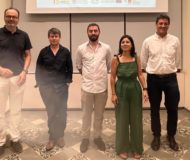

On Tuesday, July 29, the Sant Pau Research Institute (IR Sant Pau) welcomed Dr. Vladyslav Vyazovskiy, professor at the University of Oxford and one of the world’s most recognized voices in sleep research. Dr. Vyazovskiy chaired the dissertation committee for Diego del Castillo Berges, a predoctoral researcher in the Molecular Synapse Physiology group led by Dr. Àlex Bayés.
The dissertation, titled Alterations in NREM Sleep Accompany Dysregulation of Synaptic Proteome Dynamics in Syngap1 Heterozygous Mice, focuses on non-rapid eye movement (NREM) sleep, one of the two major phases of sleep characterized by slow and synchronized brain activity. This is essential for energy restoration and memory consolidation. The study specifically explores how deep sleep affects the molecular functioning of synapses in a mouse model carrying a mutation in the SYNGAP1 gene, one of the most common monogenic causes of intellectual disability and neurodevelopmental disorders.
Using proteomic and electroencephalographic analysis techniques, the study indicates that these mice exhibit significant alterations both in the molecular mechanisms regulating neuronal connections and in their sleep patterns. Under normal conditions, about 10% of the synaptic proteome follows rhythmic oscillations throughout the day. In the mutant mice, about half of these oscillations are lost, but a new set of cyclic proteins emerges, suggesting not just a loss of rhythmicity, but a pathological reorganization of synaptic function.
On a functional level, SYNGAP1 heterozygous mutant mice maintain a generally normal sleep architecture and circadian regulation of the sleep-wake cycle, but they show subtle changes in NREM sleep microarchitecture. They experience fewer microarousals and more stable periods of deep sleep, but with altered brain activity: there is an increase in delta power (associated with slow waves) and a decrease in sigma power, which reflects the activity of sleep spindles—brief, rapid oscillations typical of NREM sleep involved in memory consolidation and sensory disconnection during rest. While the mechanisms regulating brain activity during deep sleep and across the day are preserved, the pattern of sleep spindles is altered and no longer follows the usual slow rhythm. This change, together with the reduction in microarousals, suggests a possible dysfunction in the noradrenaline signaling system.
The dissertation proposes that this dysregulation of proteomic dynamics and brain oscillations during NREM sleep could be related to the cognitive and behavioral deficits observed in SYNGAP1-related disorders. Furthermore, it suggests that therapeutic strategies aimed at restoring the characteristic oscillations of NREM sleep may have beneficial effects.
Dr. Vyazovskiy’s presence as chair of the dissertation committee brought both scientific and symbolic value to the defense. His group, based in the Department of Physiology, Anatomy, and Genetics at the University of Oxford, investigates the synaptic, cellular, and neurophysiological mechanisms that regulate the sleep-wake cycle. It also studies how these processes are altered in neurological and psychiatric disorders, aging, and metabolism. He is particularly well known for his contributions to the synaptic homeostasis hypothesis, which posits that sleep plays a vital role in restoring the balance of brain plasticity accumulated during wakefulness.
His research also explores innovative areas such as local sleep (in which different brain regions may be in different functional states), torpor and hibernation, the effects of psychedelic compounds such as 5-MeO-DMT, and the detailed analysis of circadian rhythms and brain oscillations across multiple timescales.
His visit to Sant Pau was a valuable opportunity to promote scientific exchange and strengthen ties with leading neuroscience groups on the international stage. It also represents recognition of the achievements of the Molecular Synapse Physiology group, a pioneer in the study of the human synaptic proteome and the molecular alterations involved in neurological and developmental disorders.